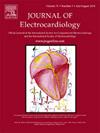沃尔夫-帕金森-怀特综合征儿科患者射频导管消融术后 QT 间期和 ST 段的变化。
IF 1.3
4区 医学
Q3 CARDIAC & CARDIOVASCULAR SYSTEMS
引用次数: 0
摘要
背景:很少有研究探讨了射频导管消融术(RFA)在表现为Wolff-Parkinson-White(WPW)综合征的儿童患者中引起的QT、JT间期和ST段变化:研究涉及27名患者(男女比例为13:14;年龄为12(5-16)岁),他们在2009年至2022年期间被诊断为WPW综合征并在我院接受了RFA治疗。结果显示,因附件通路导致室性期前收缩的一组(显性组,n = 16)与无附件通路导致室性期前收缩的一组(隐性组,n = 11)之间的心电图(ECG)变化进行了比较:结果:显性组在 RFA 前的 QT 间期明显长于隐性组(402 [362-482] vs. 344 [323-427]; p = 0.001)。在 RFA 前后,显性组的 QT 间期明显缩短(402 [362-482] 与 360 [298-422] 毫秒;P = 0.01)。1 个月后,显性组和隐性组之间的 QT 间期差异消失(366 [305-437] 对 335 [301-436] 毫秒;P = 0.001)。显性组中有 56% (9/16)的患者在 RFA 后出现 ST 段变化,而隐性组中则没有。一名患者的心电图出现了 Brugada 模式的变化。一个月后,只有一名患者的心电图仍存在异常:结论:在儿童患者中,显性 WPW 综合征的 QT 间期延长,但 RFA 后缩短。结论:在儿童患者中,显性 WPW 综合征的 QT 间期延长,但在 RFA 后缩短,显性组在 RFA 后经常观察到短暂的 ST 段变化和 T 波异常,但心电图在大约一个月后恢复正常。本文章由计算机程序翻译,如有差异,请以英文原文为准。
A change in QT interval and ST-segment after radiofrequency catheter ablation in pediatric patients with Wolff–Parkinson–White syndrome
Background
Few studies have examined QT, JT interval, and ST-segment changes due to radiofrequency catheter ablation (RFA) in manifest Wolff–Parkinson–White (WPW) syndrome in pediatric patients.
Methods
The study involved 27 patients (male-to-female, 13:14; age, 12 (5–16) years) who were diagnosed with WPW syndrome and underwent RFA in our hospital between 2009 and 2022. Electrocardiographic (ECG) changes were compared between the group with ventricular preexcitation due to an accessory pathway (manifest group, n = 16) and those without it (concealed group, n = 11).
Results
The QT interval before RFA was significantly longer in the manifest group than in the concealed group (402 [362–482] vs. 344 [323–427]; p = 0.001). The QT interval was significantly shortened in the manifest group before and after RFA (402 [362–482] vs. 360 [298–422] msec; p = 0.01). At 1 month, the QT interval difference between the manifest and concealed groups disappeared (366 [305–437] vs. 335 [301–436] msec; p = 0.001). ST-segment changes were found after RFA in 56 % (9/16) of the patients in the manifest group but not in the concealed group. ECG changes presenting the Brugada-pattern was found in one patient. One month later, ECG abnormalities persisted in only one patient.
Conclusions
In pediatric patients, the QT interval was prolonged in manifest WPW syndrome but shortened after RFA. In the manifest group, transient ST-segment change and T-wave abnormalities were often observed after RFA; however, the ECG normalized in approximately 1 month.
求助全文
通过发布文献求助,成功后即可免费获取论文全文。
去求助
来源期刊

Journal of electrocardiology
医学-心血管系统
CiteScore
2.70
自引率
7.70%
发文量
152
审稿时长
38 days
期刊介绍:
The Journal of Electrocardiology is devoted exclusively to clinical and experimental studies of the electrical activities of the heart. It seeks to contribute significantly to the accuracy of diagnosis and prognosis and the effective treatment, prevention, or delay of heart disease. Editorial contents include electrocardiography, vectorcardiography, arrhythmias, membrane action potential, cardiac pacing, monitoring defibrillation, instrumentation, drug effects, and computer applications.
 求助内容:
求助内容: 应助结果提醒方式:
应助结果提醒方式:


